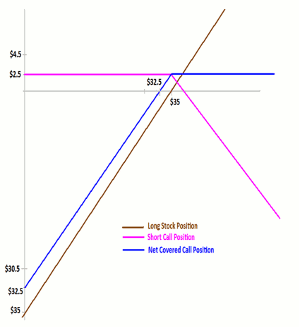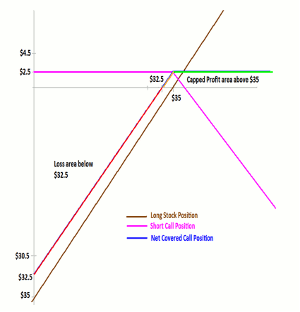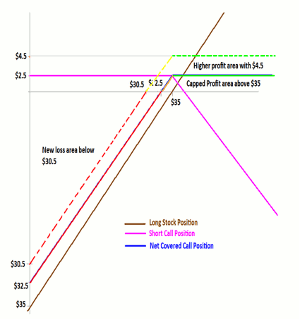Shobhit Seth, at Investopedia.com, explains how covered calls on dividend paying stocks can be used to generate higher returns with less risk. Citing the example of a high dividend paying telecom stock, Shobhit outlines how creating a covered call position has improved the profit potential significantly.
Covered calls on stocks are a popular strategy among options traders. In this strategy, combining a long position in an underlying stock with a short call provides capped returns on the upside and limited loss potential on the downside. It is a conservative strategy with a short-term neutral view on the underlying asset. Creating a covered call position on a high dividend paying stock can completely change the profit and loss. Experienced traders employ this strategy and benefit from it by timing it to perfection. This article explains how a covered call on dividend paying stocks can be used to generate higher returns with less risk.
Let’s take the example of a high dividend paying stock like AT&T, Inc. (T). Assume AT&T stock is trading at $35 today (January 2015) and an at-the-money (ATM) call option with the strike price of $35 expiring in one year (January 2016) is trading at $2.5. Assume AT&T pays a dividend of $0.5 each quarter or $2 in one year’s time.
Here is what a covered call position on this high dividend paying stock would look like (without taking into account dividends):
- BROWN Graph: Long position in stock costing $35.
- PINK Graph: Short call position in call with $2.5 receivable.
- BLUE: Net position of covered call position (net sum of BROWN and PINK).
- Total cost to create this position: -$35 (payable) +$2.5 (receivable) = -$32.5.
For simplicity, brokerage and commission charges are assumed to be zero. In real life, these should be deducted from net payoffs.
Analysis of This Position:
- If the AT&T stock price remains below $32.5, the trader will remain at a loss and that loss will increase linearly the lower the stock price goes (indicated by RED graph).
- If the AT&T stock price remains between $32.5 and $35, the profit will be linear, i.e., the higher the price goes in this range, the more profit the trader makes (indicated by ORANGE graph).
- If the AT&T stock price goes above $35, the profit remains capped at $2.5 (indicated by flat GREEN graph).
NEXT PAGE: Risk, Reward, and More
|pagebreak|Dividend—The Unsung Hero
The above analysis holds true for any covered call position in a non-dividend paying stock. However, the real hidden gem is the dividend that can change the profit and losses. During the holding period of one year, the trader will be entitled to $2 total dividend ($0.5 * 4 quarters). Now lets add the payment of +$2 to the final graph and see how the net returns change:
- If the AT&T stock price remains below $30.5, the trader will remain at a loss and that loss will continue to increase linearly the lower the stock price goes (indicated by RED dotted graph).
- If the AT&T stock price remains between $30.5 and $35, the profit will be linear, i.e., the higher the price goes in this range, the more profit the trader makes (indicated by YELLOW dotted graph).
- If the AT&T stock price goes above $35, the profit remains capped at $4.5 (indicated by GREEN dotted graph).
As we can see, creating this covered call position on the high dividend paying stock has improved the profit potential significantly. Taking the maximum capped profit of $2.5 (earlier case without dividend) and $4.5 with dividend against the cost to create this position ($32.5), the percentage profit increases from 7.69% to 13.85% (almost double).
Risks
- Brokerage charges can be higher than the profit potential, so the right option brokerage should be selected.
- Significant loss can occur if the underlying stock price goes down by large amount, for example if AT&T stock drops to $25, causing a net loss of ($25 - $35) on stock + ($2.5 from short call) + $2 from dividend = -$5.5 (or 16.9% loss on $32.5 investment). However, risk always remains limited in a covered call and the maximum risk (-$35+$2.5+$2 = -$30.5) is known in advance.
- Risk of a short call (early exercise by the buyer) can affect the overall position.
Benefits
- Profit remains limited but significantly improved by the dividend factor.
- The loss area reduces considerably from below $32.5 to below $30.5 in the above example.
- Regular dividend payments also support stock prices, even when the overall market is going down, thus improving loss prevention.
- Risk is limited and known in advance, allowing stop losses per the trader’s risk taking abilities.
Profit Sources Are the Following:
- Receipt of an option premium for shorting the call.
- Potential to benefit from stock upside during the long trading duration of covered call (a few months to one year-plus).
- Receipt of a dividend from the long stock position.
Points to Consider:
- Pick options and stocks with an established track record of regular dividend payments.
- Time your trades properly. It is recommended to take a position just one business day prior to the dividend ex-date.
- Keep track of dividend payments throughout the holding period.
- Be informed about the risk of early exercise by the buyer of short calls (short call assignment) and keep a backup plan ready.
- Keep stop-loss levels ready for any unprecedented downward moves in the underlying stocks.
The Bottom Line
Option strategies allow traders to benefit enormously with proper timing of trades. Care should be taken to keep risk-reward parameters in mind. A constant vigil on the market price movements is recommended for safe options trading.
By Shobhit Seth, Contributor, Investopedia.com
























